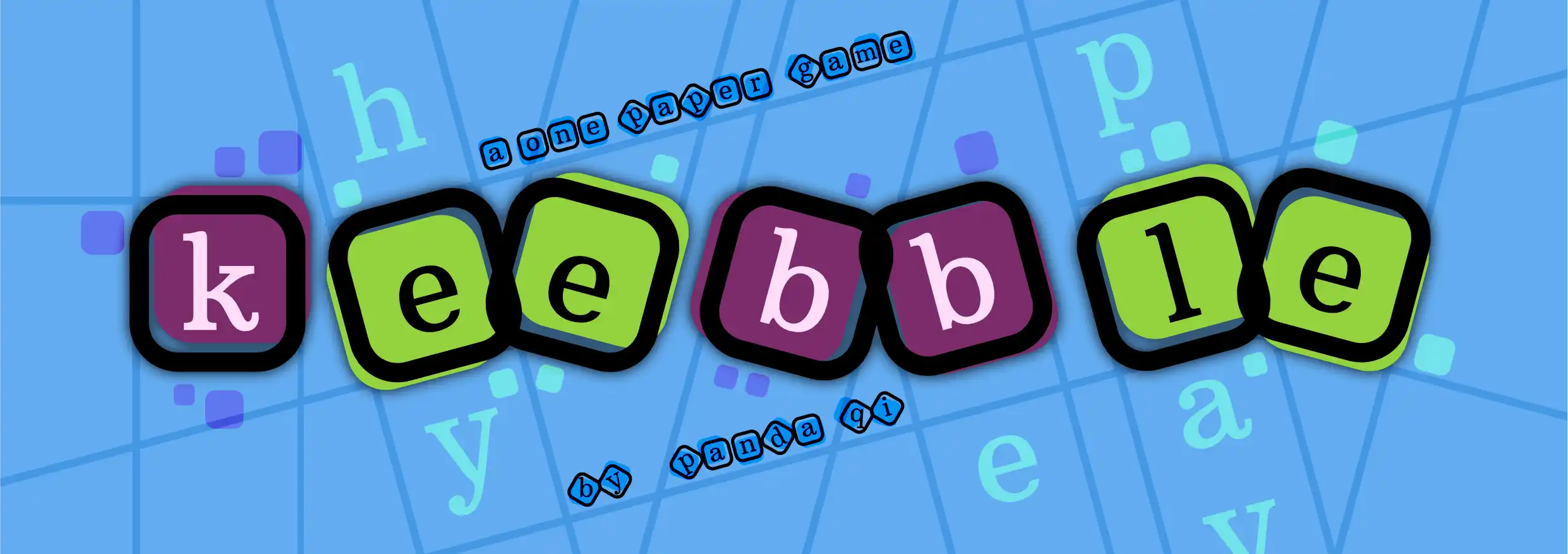
Grab a paper. Fold it in half six times: you should have 64 “cells” now.
You can start with an empty page. Or let the website generate a starting board and copy it to your paper.
Each player grabs a pen and claims one cell at the edge of the paper. You’ll use this to write down which letters you have “in your hand”.
Each turn you take the same action: play a word (optional), then ask new letters.
Once at least 10 edge cells have a letter, you enter the endgame! You can only play a word on your turn. Once somebody is out of letters, the game ends. Highest score wins!
Click the button to see an example turn, or continue reading the rules below.
Play a word using letters from your hand. Cross out the letters from your area, then draw them on the board.
This follows the well-known Scrabble rules:
- All letters must be on the same line (horizontal or vertical)
- You must form at least one new word
- Every word you form must be valid
- You score for all new words formed. (Sum the points for each individual letter in the word.)
The first word (of the game) must cover one of the four center squares. After that, words must connect to existing letters.

Unlike Scrabble, letters don’t have their own value. Instead, follow these simple rules.
- Vowel = 1 point
- Consonant = 3 points
- Unique = 5 points
Unique means nobody else has this letter in their hand.

Call out 2 letters. Anything! Whatever you want!

You get those letters in your hand. Add them to your area.
All other players make a decision:
- They either pick one of those letters and also add it to their area.
- Or they place a wall on an empty edge
A wall means marking the edge between two cells. From now on, these two cells aren’t considered “adjacent” anymore.
The hand limit is 7 letters. If full, you can’t get more letters.

Ready for more? Here’s more.
You can’t just call out any letters on your turn. Instead, pick one of the rules below.
- The letters must all be different
- You can’t say a letter you already have
- You may say at most one letter you already have
- You must pick letters that are in a straight line on the board. (If none exist, ignore this rule.)
At the start of the game, everyone invents a simple symbol. When you write letters on the board, add your symbol to mark them as “yours”. Also immediately write down the letter score in the cell.
If you score a word, any letter from another player makes all your letters worth +1 point.
Now you don’t have to keep track of score during the game. At the end, simply sum the scores in all cells you’ve placed. That’s your final score!
During setup, divide your claimed cell (your “hand”) into a grid or table. Draw 3 horizontal lines and 3 vertical lines, to get 16 small slots.
When adding a letter to your hand, write it in a free slot. Once all slots have been used, you can’t receive any more letters!
So be careful. Don’t be too greedy during the game, or you’ll be out of options soon!
Players get a new action. You can take this one instead of placing a word: place a special cell.
Pick any empty cell and convert it to a special one. Draw the corresponding icon in the top-left. However, you may not pick a type that’s currently present in an empty cell!

Below are your options.
This adds even more special cells that could be on the board! As usual, they activate when you place a letter on them.
Each letter is worth a fixed number of points. See the table.
| Letter | Points | Letter | Points | Letters | Points |
|---|---|---|---|---|---|
| A | 1 | J | 8 | S | 1 |
| B | 3 | K | 5 | T | 1 |
| C | 3 | L | 1 | U | 1 |
| D | 2 | M | 3 | V | 4 |
| E | 1 | N | 1 | W | 4 |
| F | 4 | O | 1 | X | 8 |
| G | 2 | P | 3 | Y | 4 |
| H | 4 | Q | 10 | Z | 10 |
| I | 1 | R | 1 |
This removes some strategy for the game. (And you need to remember or lookup these values.) But it does incentivize players to ask for the more “uncommon” letters and use them for big scores.
